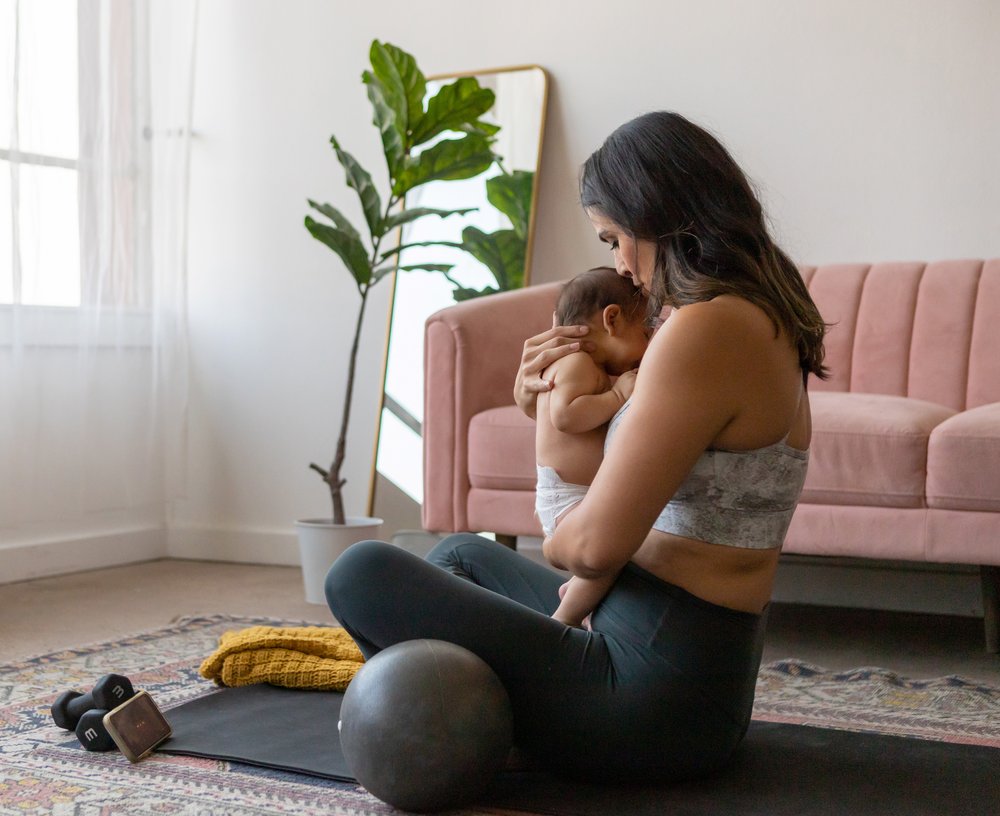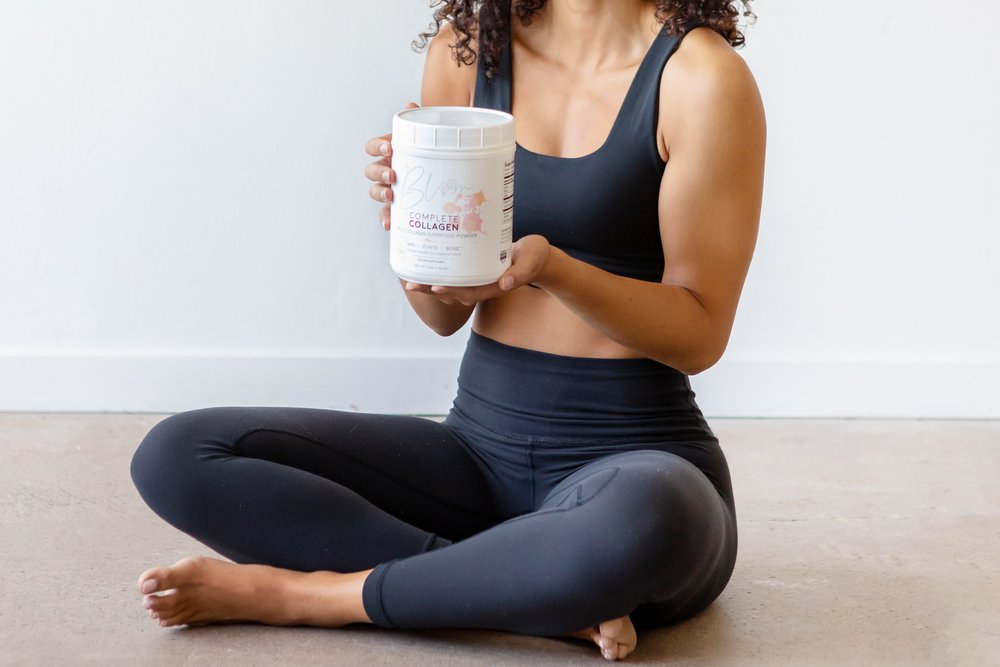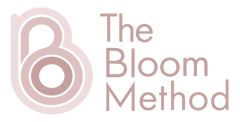How to Safely & Effectively Begin Exercise Postpartum
Returning to exercise shouldn’t be zero to one hundred. By beginning with core and pelvic floor recovery work, you’re setting yourself and your body up for future success.

The pregnancy and exercise journey is a long and winding road. During the early days of pregnancy, it can be difficult to even motivate through the fog of exhaustion and nausea. Late in pregnancy, you might be experiencing aches and pains from carrying a nearly full-term baby, and frustration at having to modify all your exercise around that enormous belly.
Then comes the postpartum period. During the first months after your baby is born, also known as the fourth trimester, rest and recovery are number one as your body heals from nine months spent growing a human. Then, all of a sudden, you’re cleared for exercise at your 6-week check-up. It’s natural to feel “all the feels” - overwhelmed, nervous, excited - as you prepare to jump back in.
What to expect from your postpartum body
You existed inside of your pre-pregnancy body for a long time - decades - and you know what that body is capable of. You spent years learning where your limits are, and how to push past them. But pregnancy changes the landscape inside and outside your body and it will take time to learn the lay of the land again.
All that is to say, when you rebuild strength after pregnancy it should be done slowly and deliberately, with respect to the journey that your body has just been on. Your body has changed, in some ways forever. There are parts of your body that are softer than before, but you’re also stronger for having experienced what it takes to bring a human being into the world.
There are, of course, some less-than-glamorous realities to navigating that early postpartum period, known as the fourth trimester. It’s normal to feel fatigued in the first few weeks (both healing and not sleeping terribly well exacerbate this), to experience some swelling in your belly, legs, and feet, and to feel “loose” in your midsection. Your body went through a lot! It’s time to honor it with rest.
The importance of rest & recovery
It’s totally possible to build back stronger after pregnancy and we’ve been honored to witness many of our Bloom mamas do this successfully. It requires a measured approach that ensures you give your body time to heal, and then focus on core and pelvic floor recovery as a first step when returning to exercise postpartum.
You’ve conceived, carried, and brought a human being into this world - respect, mama! You are strong and your body deserves some TLC.
The number one rule of recovery is to listen to your body and prioritize rest in the first several weeks of the fourth trimester. Good nutrition and hydration help speed up recovery. If you’re breastfeeding, these are two critical elements to establishing a consistent milk supply and ensuring your babe gets what they need.
At Bloom, we recommend mamas add collagen to their diets right away. Collagen promotes proper bone density, healthy skin elasticity, joint tissue health and function, muscle strength, GI health and even helping to aid in the healing of Diastasis Recti.

Relaxin & postpartum healing
Relaxin is a hormone that literally relaxes your joints during pregnancy to allow your body to adjust as needed as the baby grows and to stretch and soften when it’s time to bring baby earthside. After you deliver the placenta, the production of relaxin stops, but it’s still present in your body until new tissue forms, which takes about 5 months.
For breastfeeding moms, the production of relaxin continues until your baby is fully weaned. It’s particularly important during this time to think about properly engaging your core, even while nursing and during everyday movements around the house.
As you exercise, it’s important to be aware of the presence of relaxin and be mindful of overstretching while your joints and ligaments are still a bit loose. A postnatal belly band that is designed to give your hips, back, and abdominal muscles some support can also be helpful.
Rehab & your pelvic floor
All too often, mamas who are eager to lose the baby weight jump straight back into whatever exercise they were doing pre-pregnancy the moment they’re cleared for exercise at 6 weeks postpartum. Whether it was Orange Theory, CrossFit, or even something as basic as running - the temptation is to try to pick back up where you left off. If you do this, you might find that you pee during certain exercises.
So many women experience some level of incontinence during pregnancy and postpartum that it’s all too often chalked up as “normal” and therefore not something you can fix. If you find yourself peeing a little when you sneeze, laugh or exercise, also known as stress incontinence - it is absolutely fixable and not something you should have to or need to live with.
Muscles and fascia connect your pubic bone and tailbone, and this whole bundle of muscles forms your pelvic floor, which stretches to create a hummock-like structure to support your bladder, uterus, and bowels. Your pelvic floor literally does the “heavy lifting” during pregnancy, holding up all the extra weight of your baby, and the whole support system that goes with that, extra water, blood, placenta, etc.
All of this puts tremendous pressure on your pelvic floor, which means all mamas experience some level of pelvic floor trauma. For those who give birth vaginally (and often those who need an unplanned C-section) the pelvic floor stretches out to help bring baby earthside, which leaves it bruised and swollen.
This is why we really stress the importance of pelvic floor rehab at Studio Bloom and have a number of workouts catered specifically towards reconnecting to and strengthening your pelvic floor. While it is totally normal to experience issues with stress incontinence it’s not a permanent condition or something you should have to live with. These kinds of pregnancy-related injuries just require extra time and attention in order to properly rehab and strengthen the muscles of your pelvic floor.
A word about Kegels…
Kegels are not some magical cure for pelvic floor dysfunction. You do need to do pelvic floor exercises - but not just Kegels. When you do Kegels, you contract your pelvic floor muscles. But there are many different reasons that you might be experiencing some incontinence, and one of them could be that your pelvic floor is overly tight. In this scenario, contracting it is not helpful at all. You need to be able to relax and contract those muscles or find the full range of motion, which is something we teach inside Studio Bloom.
Understanding and checking for Diastasis Recti
There are many misconceptions (and even some fear-mongering) when it comes to Diastasis Recti. Often we find that mamas are unnecessarily afraid of getting Diastasis, while simultaneously having no idea how to prevent it. While pregnancy does naturally cause a healthy level of separation, injury-based Diastasis Recti is caused by the lack of proper core awareness and activation and exacerbated during pregnancy as your belly stretches.
The second thing to know is that there is a level of normal separation between the abdominal muscles. If you checked your abdominal separation before giving birth, you’d likely find about a 1cm or one finger width separation at your belly button and approximately .5 cm above and below. Though you will have a wider diastasis directly after giving birth, over the next two months it should naturally heal to about 1.5 to 2 cm at the belly button.
The goal when healing Diastasis Recti is not to completely close your gap. The goal is to ensure your gap returns to a manageable and normal width. There are many variables that determine whether or not your DR heals naturally, some controllable and some uncontrollable. A big determinant and a thing you can control is awareness of how you activate your abdominal muscles during pregnancy and after delivery.
If several months pass after giving birth and you notice that you still look pregnant, or you can see some doming down your midline while exercising, it might be Diastasis Recti. This width and depth of your gap is something you can check and monitor yourself. Check out this video of The Bloom Method founder Brooke Cates demonstrating how to check the integrity of your midline connective tissue:
If after checking, you determine that you do have Diastasis Recti, make sure to avoid any exercises that put a lot of pressure on the abdominals. Studio Bloom’s The Rehab Code includes all the foundational techniques required to heal diastasis recti and pelvic floor-related injuries and can be started as early as Day 1 postpartum.
We would also recommend getting assessed by a pelvic floor therapist who can double-check the width of your separation and suggest specific exercises to help strengthen your transverse abdominals and other muscles that support your core.
Managing nutrition and hydration during postpartum exercise
Especially if you are breastfeeding, it’s important to remember that if you’re exercising, you’ll need even more than the 500 extra calories you need per day just to maintain your milk supply. In general, we recommend eating to your hunger levels and listening to your body, but be aware that you’ll probably need a substantial breakfast, lunch, and dinner, plus snacks.
If you need help understanding your nutritional requirements or planning meals that optimize your milk supply, The Bloom Method has a nutrition guide and meal plan that will help you on your journey.
Including a smoothie with a high-quality protein powder after a workout is a great way to ensure your body is getting what it needs to build muscle, recover from pregnancy and make enough milk for your baby if you are nursing.
Hydration is another important consideration. A nursing mom needs about 16 cups of water a day (this includes water from food, fruits, and drinking water). If you work up a sweat while exercising you might find it difficult to catch up, and electrolytes can be super helpful for quickly rehydrating you and replacing minerals.
Our favorite “workouts” for the fourth trimester
Inside Studio Bloom, we have everything you need to get back into exercise postpartum - the right way. Mamas who are super eager to fit into those pre-pregnancy jeans - we see you, and we can help you get there, BUT in the early days, it’s critical to focus on nutrition and rehab in order to lay a good strong foundation for the months and years to come.
Starting with our 4th Trimester Rehab, you’ll learn how to reconnect with your core and pelvic floor, and then build strength in a safe and effective way. If you’re still experiencing any issues once you’ve completed rehab, we have a variety of pelvic floor workouts that help to build strength and tackle issues like incontinence and pelvic organ prolapse. It can also be really helpful to go back and do some of the rehab workouts multiple times to focus on areas you know need improvement.
From there, we have more advanced guided programs as well as a variety of workouts to pick and choose from, depending on time (like express workouts) or personal preference for cardio, strength, yoga, etc.
The Bottom Line
The return to exercise postpartum will look different for every single mama, after every baby. At Studio Bloom, we always encourage mamas to spend those early days focused on rest, recovery, and bonding with their new addition. It’s also important to eat nutritious, healing food, drink water often, and ask for help when you need it - whether it’s so that you can get a shower, nap, or a bit of exercise. Self-care isn’t selfish, it’s essential.



